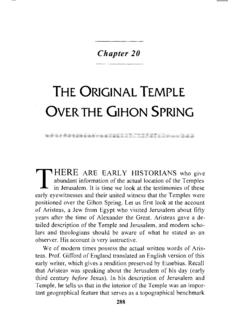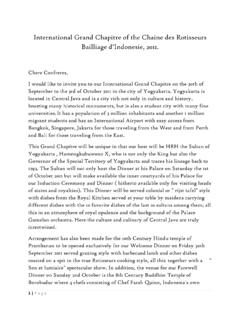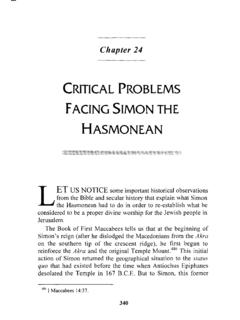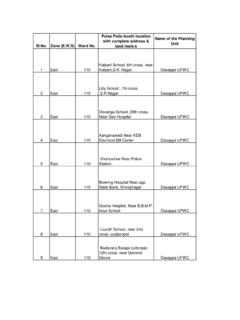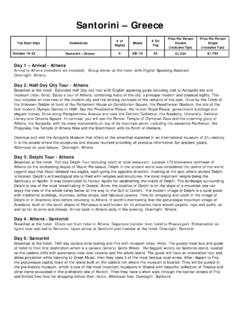Transcription of introduction - Angkor guide
1 There are over a hundred major temple sites to be visited in andaround Siem Reap - the religious remains of a series of cities, builtby a succession of kings from around the 7th to the 13th civic and domestic buildings were built in timber and have longsince disappeared, so not much is known about the lives of thecivilians - although some 1,200 inscriptions found throughout theregion and the remains of a vast irrigation system indicate thescale and complexity of the was mainly used for the earlier temples, with increasing usethen being made of laterite, a rust coloured mudstone, and finallyof sandstone, which was quarried mostly from the Kulen hills, 40kilometres to the north-east of Siem Reap. Many were built as' temple mountains' or pyramids, symbolic of the cosmic MountMeru of Hindu mythology.
2 The five tiered mountain at the centre ofthe universe (the temple ), was said to be encircled by seven chainsof mountains (the enclosure walls) which were surrounded in turnby the sea (the moat). The map indicates the major accessible sites, which are listed inchronological order. Dates given are of the consecration of theprincipal divinities and an asterisk rates information is from research by the cole Fran aise d'Extr Tremmel19941Ak Yum * VsaT GkyMbeginning of 7th century, HinduThe first temple mountain and one of the earliest known sites in thearea, preceding the first Angkor and thought to be central to thefirst ancient capital city. A small three tiered pyramid in brick withprimary elements in sandstone, still mostly buried under the 11thcentury dike of the western baray.
3 Inscriptions give the dates 609AD, 704 AD and 1001 AD and reveal that the temple wasdedicated to the god Ko **(Roluos Group) VsaT BHeKa879 AD, Indravarman IHindu (Shiva)The funerary temple of Jayavarman II and his predecessors,enclosed within a moat of 400 by 500 metres. The foundation stele(an inscribed monolith) tells of the genealogy of Indravarman I, witha reference to the cult of the god king, and the foundation date ofthree statues of Shiva and Devi in 879 AD. The other face of theinscription dates from 893 AD under the reign of Yasovarman anddescribes certain dedications. The temple still has a large area ofmoulded stucco (a lime-based plaster mixture) remaining intact,though only **(Roluos Group) VsaT VKg881 AD, Indravarman IHindu (Shiva)A temple mountain enclosed by a laterite wall and two moats, theouter of which measures about 900 by 700 metres.
4 The third suchtemple after Ak Yum and Rong Cheng (at Phnom Kulen to thenorth east) and the first to make extensive use of sandstone. Thestele tells of the foundation of the linga (a stone phallus,representative of Shiva) in 881 AD. The brick towers have finelydetailed sandstone elements and some remnants of stuccomoulding. The central sanctuary in the Angkor Wat style, whichwas probably built two centuries after the main temple , wasresurrected from a pile of rubble between 1936 and 1943. 4 Lolei *(Roluos Group) VsaT l\l893 AD, Yasovarman IHindu(Shiva)Four brick towers (though perhaps originally six) set on a twotiered base in the middle of the Lolei Baray, (Indratataka), a largeancient reservoir of by kilometres.
5 Excavation of the baraybegan, so the inscription tells us, five days after the consecrationof Indravarman I at Bakong, in order to irrigate the capital citycentred there. The temple , built subsequently, is dedicated to Bakheng ** VsaT P~MVExgend of 9th century, Yasovarman IHindu (Shiva)Located at the centre of the first capital of Angkor which formed asquare of about 4km surrounded by a moat of which the south westquarter is still visible. The remains of an inner enclosure of 650 by436 metres surrounds the base of the hill. A 'natural mound' fivetiered pyramid temple , the bulk of which is hewn from the bed-rockand faced with sandstone. The location gives good views over thesurrounding landscape, particularly at Krom ** VsaT P~Me kamend of 9th century, Yasovarman IHinduPerhaps the second of three temples built by Yasovarman I on thehills dominating the Angkor plain - the others on Phnom Bakhengand Phnom Bok.
6 Badly deteriorated. Enclosed in a square lateritewall, three sandstone sanctuaries aligned north-south arededicated to the Brahmanic trinity - Shiva between Vishnu (north)and Brahma (south). Good views over the Tonle Sap Thma Bay Kaek * VsaTVyEk)k10th century A ruined single square brick tower preceded to the east by alaterite terrace, situated between Baksei Chamkrong and the moatof Angkor Thom, 125 metres west of the main road. When clearedin 1945, five gold leaves arranged in a quincunx where found underthe base Bei * VsaT bI10th century Hindu (Shiva)Three small brick towers aligned north south on a common lateritebase, 175 metres west from the above. 9 Prasat Kravan * VsaT kv"an'921 AD, Hashavarman IHinduFive brick towers, aligned north - south on a common brick base,within a single enclosure and moat.
7 The extensive brickworkrestoration uses cement mortar where originally there would onlyhave been a thin vegetal adhesive or clay slurry. The inscribeddoor frames mention the setting of a statue of Vishnu in 921. Thereare bas-reliefs representing Vishnu, and other representations ofLakshmi in the internal brickwork of the central tower, and of thenorthern most tower. Best in the morning sun. 10 Baksei Chamkrong * VsaT bk!IcaM kug947 AD, Hashavarman I, Rajendravarman IIHindu (Shiva)A temple mountain set back in the trees at the base of PhnomBakheng, in materials typical of the 10th century. A brick toweropening to the east and originally decorated with stucco mouldingsurmounts four diminishing tiers in laterite, the upper most of whichis moulded, enclosed within a brick wall which has virtuallydisappeared.
8 Four axial stairs each ascend in a single Oriental ** VsaT embuN2xagekIt952 AD, Rajendravarman IIHindu (Shiva)At the centre of the Eastern Baray and so originally only accessibleby boat. All the characteristics of a temple mountain in brick andlaterite but with a three metre high platform carrying five towersarranged in a quincunx rather than a central tiered pyramid. A largefoundation stele describes the dedication to the king's east west axis of the temple aligns with the principal entry tothe royal palace in Angkor Thom. Sandstone lintels are superblydetailed. Monolithic elephants stand at the four corners of eachenclosure, those to the south west being particularly wellpreserved. Good in the late Chum * VsaT VtCuM953 AD, Rajendravarman IIBuddhistThe first known Buddhist temple .
9 Three brick sanctuaries with themain architectural elements in sandstone on a common mouldedlaterite base. Inscriptions give details of dedications to threeBuddhist divinities and reveal the architect of the Eastern Mebonas its patron and Rup ** VsaT E brUb961 AD, Rajendravarman IIHindu(Shiva)On the same north south axis as the Eastern Mebon which itfollows by only 9 years. Similar in style and composition, thoughmuch grander. Again built almost entirely in laterite and brick butwith the main architectural elements in sandstone. The lintels arefinely detailed - some remain unfinished. The upper brick towerswould have been adorned with stucco moulding. Probably centralto the second capital which developed following its return from KohKer to where it moved between 921 and 944.
10 It is thought that theroyal palace was situated close Srei ** VsaT bn8ay sI967 AD, Rajendravarman II, Jayavarman VHindu (Shiva)A temple in the forest 25 kilometres to the north east of AngkorThom. A jewel to which the nature of the material used - a finelytextured rose coloured sandstone - is perfectly size and architectural theme give way to a miniaturescale and a dense and exquisite detail in near perfect and reconstructed between 1931 and 1936. 15Ta Keo ** VsaT taEkv11th century, Jayavarman V, Suryavarman IHindu (Shiva)An imposing five tier temple mountain built predominantly insandstone and surrounded by a moat. Perhaps central to the nextcapital. Best approached from the original eastern entrance wherethe massive form of the temple is presented framed in trees at theend of the entrance causeway.
